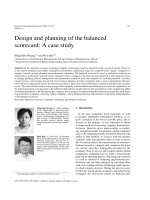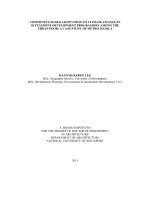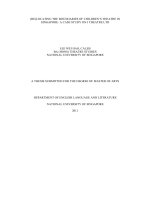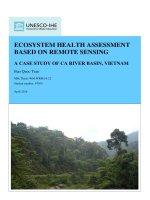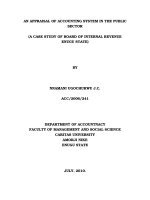Improving Intercultural Communication in the Cooperation Organizations A case study on Taiwanese Organizations in Vietnam (LV thạc sĩ)
Bạn đang xem bản rút gọn của tài liệu. Xem và tải ngay bản đầy đủ của tài liệu tại đây (1.26 MB, 91 trang )
國立屏東科技大學熱帶農業暨國際合作系
Department of Tropical Agriculture and International Cooperation
National Pingtung University of Science and Technology
碩士學位論文
Master’s Thesis
改善企業組織跨文化溝通 ─ 以在越南之台灣企業為例
Improving Intercultural Communication in the Cooperation
Organizations - A case study on Taiwanese Organizations in
Vietnam
指導教授 Advisor:陳啟政 博士 (Chee-Cheng Chen, Ph.D.)
研 究 生 Student:阮梅香(Nguyen Mai Huong)
中 華 民 國 1 0 5 年 6 月 1 5 日
June 15, 2016
摘 要
學號:M10322040
論文題目:改善企業組織跨文化溝通 ─ 以在越南之台灣企業為例
總頁數:78 頁
學校名稱:國立屏東科技大學
系(所)別:熱帶農業暨國際合作系
畢業時間及摘要別: 104 學年度第 2 學期碩士學位論文摘要
研究生:阮梅香
指導教授:陳啟政 博士
論文摘要內容:
找到在自己以外的國家運營的許多企業管理者是企業行銷全球化的
要求。留住外籍人士是具有全球業務的多國公司(MNCs)的困難。據
估計,在外派任務之人士估計有 10-80%回國過早。外籍人士的居留不
長其中一個原因一直被認為是這些經理和/或他們的配偶無力適應東道國
的文化。越南和臺灣之間的經濟關係已經建立了幾十年。事實上,越南
是臺灣最重要的市場之一。大部分臺灣公司位於越南的子公司或合資企
業或業主公司。因此,臺灣和越南之間的跨文化溝通的問題一直受到關
注,這並不奇怪。
這項研究的重點是越南和臺灣的個人和團隊之間的互動與合作,通
過文化理論的視野,包括價值取向,跨文化溝通和跨文化經營的行為。
本研究著手探索和面對越南和臺灣的個人和團隊合作的挑戰提出報告,
並發展出這兩個國家的人民之間的未來合作的想法。本文提出了一種質
性研究代表並討論了調查中的越南和臺灣之間勞動力的互動溝通行為的
調查結果 調查結果。這項調查是在 49 台公司與越南和臺灣員工進行了
越南合作,與代表探討兩個民族的個體之間相互作用的跨文化的目的。
I
研究闡明在越南和臺灣人民之間的文化特色和團隊協作的風格很多
不同之處。這些差異有潛在創造出障礙,但也許更重要的是,這些差異
顯然也可以成為依賴于跨文化意識,能力和反思走向新的思路和所涉及
的個人觀點職場優勢。文章的結論是,個人和團隊,越南和臺灣應該追
求實現其他文化的更廣泛和更深入的理解與著眼於提高個人之間的合作
互動為目標的過程。結果表明,不同類型的跨文化培訓的外籍人士的影
響“的調整,提高臺灣企業在越南的跨文化溝通的有效性。
關鍵字:跨文化溝通、商務溝通、跨文化、越南、臺灣
II
Abstract
Student ID: M10322040
Title of Thesis: Improving Intercultural Communication in the Cooperation
Organizations - A case study on Taiwanese Organizations in
Vietnam
Total Page: 78 pages
Name of Institute: Department of Tropical Agriculture and International
Cooperation, National Pingtung University of Science
and Technology
Graduate Date: June 15, 2016
Degree Conferred: Master Degree
Name of Student: Nguyen Mai Huong
Adviser: Chee-Cheng Chen, Ph.D.
The Content of Abstract in This Thesis:
The demands of marketing globalization find many business managers
operating in countries other than their own. Multinational corporations
(MNCs) are having difficulty retaining expatriates for their global operations.
It is estimated that 10–80% of expatriates sent on foreign assignments return
home prematurely. One of the reasons for expatriates’ failure has been cited
as the inability of these managers and/or their spouses to adapt to the hostcountry’s culture. The economic relationship between Vietnam and Taiwan
has been established for several decades. In fact, Vietnam is one of the most
important markets for Taiwan. Most of the Taiwan companies located in
Vietnam are subsidiary companies or joint ventures or owner companies.
III
Thus, it is not surprising that the issue of intercultural communication
between the Taiwanese and the Vietnamese has gained attention.
This research focuses on interaction and cooperation between
Vietnamese and Taiwanese individuals and teams through lenses of cultural
theory, including values orientations, intercultural communication and crosscultural business behaviors. The research set out to discover and report on
cooperation challenges faced by Vietnamese and Taiwanese individuals and
teams, and to develop ideas for future cooperation between people from these
two nations. This paper presents a qualitative and quantitative study which
represents
and
discusses
the
survey
results
of
investigating
the
communication behavior among interacting between Vietnamese and
Taiwanese workforces. The survey was conducted with Vietnamese and
Taiwanese employees in forty nine Taiwan Company worked in Vietnam,
with the purpose of exploring intercultural interactions between individuals
representing the two nationalities.
The research illuminated many differences in cultural characteristics and
teamwork styles between Vietnamese and Taiwanese people. These
differences have the potential for creating barriers, but perhaps more
importantly, these differences clearly can also become advantages in the
workplace depending on the intercultural awareness, competence and
reflexivity toward new ideas and perspectives of the involved individuals. The
paper concluded that individuals and teams, both Vietnamese and Taiwanese
should pursue a course of attaining a broader and deeper understanding of the
other culture with the goal of focusing on improving cooperative interaction
between individuals. The results show that different types of cross-cultural
training affect expatriates’ adjustment and improve effectiveness of
intercultural communication in Taiwan companies in Vietnam.
Keywords: intercultural communication, business communication, crossculture, Vietnam, Taiwan
IV
Acknowledgement
In grateful recognition and sincerest thanks for the encouragement,
guidance and unselfish of their knowledge, time, effort and skills, and for the
untiring motivation that leads to the completion of this study, the Researcher
acknowledges the following:
Supervisor Dr. Chee-Cheng Chen, Ph. D. for his untiring effort and
belief that is collaboration is possible thus enabling us to pursue the MBA
degree, I will always be thankful to him for all the hard work and efforts his
have put in, for educating me. Thank You for all the things his have done for
me.
National Pingtung University of Science and Technology for give me
scholarship and support when I am study in our school.
Dr. Nguyen Tuan Anh, Ph.D. Dean of the International School, Thai
Nguyen University of the Socialist Republic of Vietnam, for his enormous
pursuit to provide the Vietnamese people an opportunity to grow through
education;
My family and friends for the love and support in one way or the other;
and to all.
From bottom of my heart, sincerely thank you!
V
Contents
摘要 ....................................................................................................................I
Abstract ......................................................................................................... III
Acknowledgement .......................................................................................... V
List of Figures ................................................................................................. X
List of Tables................................................................................................ XII
CHAPTER I: INTRODUCTION .................................................................. 1
1.1. Research Background and Motivation .................................................. 1
1.2. Research Objectives .............................................................................. 4
1.3. Research Contribution.......................................................................... 4
1.4. Research Process ................................................................................... 5
1.5. Research Organization .......................................................................... 6
CHAPTER II: LITERATURE REVIEW..................................................... 8
2.1. Intercultural Communication ................................................................ 8
2.1.1. Communication – A Definition ........................................................ 8
2.1.2. Intercultural Communication – A Definition ................................. 13
2.1.3. Intercultural Communication in a Working Environment .............. 14
2.2. Culture ................................................................................................. 16
2.2.1. Introduction culture......................................................................... 16
VI
2.2.2. The importance of culture ............................................................... 16
2.2.3. Culture and society ......................................................................... 17
2.3. Intercultural Competence & Training ................................................. 18
2.3.1. Intercultural Competence ................................................................ 18
2.3.2. Intercultural business communication ............................................ 21
2.3.3. Six Dialectics of Intercultural Communication .............................. 23
2.3.4. Intercultural Communication and power ........................................ 26
2.3.5. Intercultural Communication and Technology ............................... 26
2.3.6. Intercultural Training ...................................................................... 27
2.4. Research gaps ...................................................................................... 30
CHAPTER III: METHODOLOGY ............................................................ 34
3.1. The nature of the research ................................................................... 34
3.2. Qualitative & Quantitative research.................................................... 34
3.3. Data collection methods ...................................................................... 35
3.4. Population and Sample.......................................................................... 37
CHAPTER IV: ANALYSIS AND RESULTS ............................................ 39
4.1. Designation ........................................................................................... 39
4.2. Nationality ............................................................................................. 40
4.3. Gender ................................................................................................... 40
VII
4.4. International Work Experience ............................................................. 40
4.5. The Main Means of Communication with other Nationalities ............. 41
4.6. Preferred type of Communication ......................................................... 43
4.7. On Business Alone or with Family ....................................................... 45
4.8. Training required equipping expatriates with skills to live in a foreign
country.......................................................................................................... 46
4.9. Major Cultural Adjustments Experienced ............................................ 47
4.10. Time Keeping ...................................................................................... 49
4.11. The Most Preferred Method of Working ............................................ 50
4.12. Preferred type of rules and instructions .............................................. 51
4.13. Different cultural ways of dealing with business................................ 52
4.14. Interaction with international partners ................................................ 54
4.15. Cultural influence on business communication .................................. 55
4.16. Enquiring about the possible barriers to successful intercultural
communication ............................................................................................. 56
4.17. Improving knowledge of the other culture ......................................... 58
4.18. The most preferred way of learning about other cultures ................... 59
CHAPTER V: CONCLUSION .................................................................... 61
5.1. Reaearch Conclusions ........................................................................... 61
5.2. Research Recommendations ................................................................. 63
VIII
References ...................................................................................................... 65
APPENDIX A: Personal Information ........................................................ 70
APPENDIX B: Questionnaire Checklist ..................................................... 72
IX
List of Figures
Figure 1-1: Research Process ............................................................................ 7
Figure 2-1. Communication model (Lustig & Koester, 2003)........................ 10
Figure 2-2. Components of the Communication Process ............................... 12
Figure 2-3. Intercultural Communication Model ............................................ 31
Figure 4-1. Job titles (Vietnamese & Taiwanese) ........................................... 40
Figure 4-2. International Work Experience .................................................... 41
Figure 4-2. Communication with other Nationalities ..................................... 42
Figure 4-4. Preferred type of Communication ................................................ 44
Figure 4-5. Major Cultural Adjustments Experienced .................................... 47
Figure 4-6. Positive or negative of Cultural ................................................... 48
Figure 4-7. Time Keeping ............................................................................... 49
Figure 4-8. The Most Preferred Method of Working ..................................... 50
Figure 4-9. Preferred type of rules and instructions........................................ 51
Figure 4-10. Different cultural ways of dealing with business ....................... 52
Figure 4-11. Interaction with international partners ....................................... 54
Figure 4-12. Cultural influence on business communication ......................... 55
Figure 4-13. Possible barriers to successful intercultural communication ..... 57
Figure 4-14. Knowledge of the other culture .................................................. 58
X
Figure 4-15. Preferred way of learning about other cultures .......................... 60
XI
List of Tables
Table 4-1. Gender composition ....................................................................... 40
Table 4-2. Type of Business............................................................................ 45
Table 4-3. Training required ........................................................................... 46
XII
CHAPTER I
INTRODUCTION
1.1.
Research Background and Motivation
Owing to i come from Vietnam, I can claim that I have a profound
understanding of Vietnam, its culture and its traditions. In the living time, I
have met many people from all over the world who came to Vietnam for
distinct reasons and with various objectives. Generally, one can categorize
these people into three groups: tourists, foreign students and business people
who work or seek to found their own business in Vietnam. When
encountering with people from these groups I discovered that most of them
face numerous problems predominantly based on cultural differences and
misunderstandings. In colloquial terms, many people do not understand
Vietnam. However, it is crucial to acquire a sophisticated knowledge about
Vietnamese culture, especially if one obtains the objective of becoming a
valuable and more importantly competitive business person. Obviously, the
language barrier creates a number of obstacles one must overcome.
Intercultural misunderstandings arise when people from different cultural
backgrounds, interpret communication signals in different ways (BroszinskySchwabe, 2011). Nevertheless, being fluent in Vietnamese language does not
consequently lead to being a competent and competitive member of the
business world. Unfortunately, often people are under the impression that
adequate language skills are sufficient to work successfully in an international
environment. Through talking to lots of people and been living in Vietnam
now, I have come to the point of view that additionally to the language barrier
it is vital also to acquire profound knowledge about the host country’s culture
and become aware of the inevitable differences to one’s own culture. This is
because culture has strong effects on every aspect of life, which includes how
people do business and communicate. Communication is a crucial factor in a
working environment. It can be the crucial factor that decides whether a
1
meeting, a deal pitch, work performance or the launch of a new product is
successful or a lost opportunity. “Culture […] is a significant factor in how
people communicate and how they perceive any form of communication.”
(Patel, Li, & Sooknanan, 2011). However, as mentioned in many literary
sources, companies neglect the importance of cultural knowledge and its
benefits. Thus, the paper in hand will focus on these issues.
Furthermore, I argue that cultural differences have a strong influence on
corporate culture and developing company. Corporate culture is increasingly
becoming one of the most important competition factors in the process of
globalization (Rothlauf, 2012). Therefore, it is crucially important to
investigate to how national and foreign culture affect corporate culture and
what issues may arise. For these reason, I believe one has to enlarge his or her
social, communicative, and business competences. When working in an
international setting it is vital to realize that approved modus operandi,
proceedings and courses of action regarding communication and employee
management often are ineffective and abortive (Blom & Meier, 2004). People
from different cultural backgrounds differ in many aspects, such as values,
beliefs, religion, tradition, history, family structure, education and social
norms. Continuously, these aspects have an effect on how people
communicate
and
do
business.
“Effective
cross-cultural
business
communication depends on acquiring an understanding of basic cultural
differences and the various patterns of verbal and nonverbal behavior among
members of different cultures” (Maude, 2011). Thus, it is not surprising to
conclude that in comparison to companies that deal with national corporate
management in rather commonly known socio-political environment
international managers have to make important decisions in much more
complicated and relatively unknown settings (Blom & Meier, 2004). One who
wants to internationally successful will face novel problems which result from
having contact with foreign countries, cultures, economic and socio systems.
One must not neglect these aspects but include these in every decision making
processes as “[c]ultural concepts provide the framework for action” (Rothlauf,
2
2012). To do so one must identify the main cultural concepts and differences.
Furthermore, one has to comprehend in what way these cultural distinctions
affect daily business life and to what extent. “Anticipating and understanding
cultural differences and being able to adapt to the way you communicate
accordingly is the foundation of any successful international business”(Carté,
2008). This will be the major objective of this paper.
As already indicated above, one must identify communicational, cultural
and behavioral patterns. For the most part literary sources mutually agree on
the importance of these factors. However, even though many researchers
stress the importance of the discrepancies these concepts may contain in itself,
they ignore the fact that the essence of this knowledge and competences is a
two way street. In other words, Vietnamese may have a different
understanding of the essence and objective of concepts, which have been
characterized as very important by numerous books and surveys dealing with
how to do business in Vietnamese. Many Western researchers have neglected
this thought. Generally, intercultural communication and other concepts that
are significant in the business world are biased towards a Western worldview
(Patel et al., 2011).
“The
universal
application
of
these
concepts
and
theories
(communication competence and moral competence), which unfortunately
inform many of the current trends of academic inquiry, not only invites
misunderstanding, but also imposes unfair judgments on non-Western
cultures” (Xiao & Chen, 2009). Only recently very few researchers came to
that realization. Thus, it is important to understand how Vietnamese identify
these concepts.
The survey in hand will look at one issue with special interest, namely
improving effectiveness of intercultural communication through Cross cultural Training using the Example of Taiwanese Organizations that are
located in Vietnam. I have chosen this example because now have many
3
country in the world want investment in Vietnam, the economic relationship
between Vietnam and Taiwan has been established for several decades,
Vietnam is one of the important markets for Taiwan, also because of my own
ethnicity.
1.2.
Research Objectives
This study has five specific objectives including:
1. Identify cultural similarities and differences,
2. Investigate the significance of cultivating intercultural awareness,
3. Identify the role culture plays in communication,
4. Determine the problems and consequences related to intercultural
communication,
5. Understand the term cultural shock and its significance to intercultural
communication.
1.3. Research Contribution
A survey about intercultural business communication among Vietnamese and
Taiwanese employees is nowadays very important due to several factors.
First, the literature has been neglecting important aspects in the field of
international communication. Researchers have been focusing on the Western
point of view while eliminating the Vietnamese understanding of significant
concepts. Furthermore, during my research I could not find a profound survey
focused on the communication relationship between Taiwanese and
Vietnamese employees working together in Vietnam that also attached
importance to cultural concepts and its influences on communication
behavior. It is crucial to notice that both counterparts are influenced by its
culture and consequently outline the scope of these influences. It is imperative
to identify these cultural concepts, its substance and in what way they affect
daily business life. While doing research on this topic, I had to conclude that
researchers predominantly have been focusing on either how to do business
with Vietnamese or how to meet the needs of Vietnamese customers.
However, again I could not find a proper survey about how cultural traditions
4
affect cooperation between Vietnamese and Taiwanese working for the same
company on a daily basis. No researcher has made a distinction between how
employees communicate with members of distinct hierarchy levels either
which seems to be an obvious aspect to investigate for someone who does
research about Vietnamese business culture and communication habits.
Surprisingly, I was unable to find such surveys. Do employees from different
cultural backgrounds use different communicative patterns when talking to
subordinates, equals or superiors? If so, in which aspects does communication
behavior differ? In addition, I could not find a survey that deals with the
importance of intercultural training and how members of the intercultural
working environment perceive its necessity and importance. Thus, I decided
to conduct an empirical research to qualitative and first hand data with the
purpose to fill the research based on improving intercultural communication
in the cooperation organizations - A Case study of Taiwanese Organizations
in Vietnam
1.4.
Research Process
The structure of the work in hand consists of three main parts. First, I
will give more details about the questionnaire I conducted which serves as the
basis of this paper. I will explain the design of the survey; how I accrued the
data and finally I will present the evaluation.
Because “it is important to understand the basic theories and concepts of
both culture and communication” (Patel et al., 2011) the following chapters
will provide a profound explanation. In both chapters, I will give an insight of
the general understanding of these concepts. Continuously, the chapters will
also focus on the managerial and business aspect of culture and
communication, and the interrelated connection of all. The following leading
questions will assist when examining the field of culture:
What are the main cultural concepts of both ethnicities?
To what extend do cultural concepts affect daily business life?
5
How can one avoid, prevent and solve cultural issues?
How can a company successfully implement national culture with
corporate culture?
When investigating the area of communication these subsequent questions
will be of high importance:
What are the main barriers in a company’s internal communication
between its Vietnamese and foreign employees?
Is there a difference in Taiwanese and Vietnamese conceptions of
communication and culture?
To what extend do communicational issues arise and affect daily
business life?
How
can
business
management
avoid,
solve
and
prevent
communicational issues?
How can a company address best to cultural differences sin its internal
communication concepts?
Throughout the paper the results of the empirical survey will be
considered in the argumentation.
1.5.
Research Organization
Chapter 1: Introduction – Present research background and motivation,
research objectives, research contribution and research framework.
Chapter 2: Literature Review - Introduce the literature review of relative
previous researches and theories.
Chapter 3: Methodology - Address the methodology of the research.
Chapter 4: Analysis Results–Address key findings of the research
through a case study analysis.
6
Chapter 5: Conclusion – Summarize the conclusions of the research, give
suggestions and recommendations and point out research limitation.
Research Objectives
Literature Review
Culture
Introduction
culture
Intercultural
Communication
The importance
of culture
Culture
society
and
Communication
– A Definition
Intercultural
Communication
– A Definition
Social factors
Intercultural
Communication
in a Working
Environment
Intercultural
Competence
Intercultural
Competence
Intercultural
business
communication
Six Dialectics of
Intercultural
Communication
Intercultural
Communication
and power
Intercultural
Communication
and Technology
Intercultural
Training
Reseach gaps
Data Collection
Quantitative research
(Questionnaire)
Qualitative research
Case Study Analysis
Taiwan Organizations in Vietnam
Conclusion
Suggestions and Recommendations
Figure 1-1: Research Process
7
CHAPTER II
LITERATURE REVIEW
The paper in hand deals with intercultural communication among
Vietnamese and Taiwanese in a working environment. In order to understand
communication and its characteristics and if so, differences given in an
intercultural setting, first one has to fully understand the concept of
communication among human beings in a more general sense. Interestingly,
this is has been ignored by a large number of authors and scientists who
engage with the topic of intercultural communication. Instead, they focus only
on what communication in an intercultural setting means. However, it is vital
to first understand the concept of communication. One has to become aware
of the fact that communication is not only the bare conveyance of information
between two or more persons, but a complex process of language exchange
which can take place verbally, non-verbally, virtually, and so on. Therefore,
in the next chapter I first will discuss communication from a theoretical rather
general point of view. Secondly, communication will be highlighted within
the scope of the international working world to provide the reader with
necessary knowledge in order to understand the later discussion about how
cultural concepts affect the communication process.
2.1.
Intercultural Communication
2.1.1. Communication – A Definition
Communication is a term that one comes across in all kinds of situations,
contexts and cultures. Thus, it is not surprising that different scientific fields,
for instance anthropology, psychology, economics and linguistics to name a
few, have been employing themselves with finding a definition. Precisely
because of this, it is simply impossible to come up with a definition of
communication that is universally true. Even though the term is an integral
part of everyday language, its meaning is not always as clear as it seems. The
8
following examples of definitions show how the term communication can be
perceived in different ways:
“Communication is a symbolic, interpretative, transactional, contextual
process in which people create shared meanings.” (Lustig & Koester, 2003)
“Communication is social interaction through symbols and message
systems.” (Gerbner, 1966)
“[T]he two terms communication and behavior are used virtually
synonymously.
[...]
[A]ll
behavior,
not
only
speech,
is
communication.“(Watzlawick et al., 2011)
“In its broadest sense, this term refers to every kind of mutual
transmission of information using signs or symbols between living beings
(humans,
animals),
between
people
and
data-processing
machines.”(Bussmann, 1996)
All of these citations regarding communication show differences and
similarities to one another. Generally speaking we can agree that
communication is a means of exchanging messages that human beings use in
order to generate meaning. This kind of message exchange takes place in and
via various contexts, cultures and channels. As mentioned above, this paper
deals with the communication across cultures and thus it will distance itself
from any mathematical or media approach. I will look at communication not
from the bare transfer of information but consider it as a structural process of
interaction and understanding between at least two human beings (Figure 1).
The activity of communication does not only involve verbal but also
vocal and non-verbal elements such as intonation, tone, mimics and gestures.
It is important to understand that communication is a two-way process in
which both counterparts act as a sender and as a receiver. This means, one
person does not only send a message but also receives one which results in an
9
interactive communication which goes in line with the etymological meaning
of the term (latin communicare which means sharing or imparting).
Message
Encode
Decode
Sender/Receiver
Sender/Receiver
Encode
Decode
Feedback/Message
Figure 2-1: Communication model (Lustig & Koester, 2003)
When the counterpart reacts to the message received and sends feedback,
it becomes clear whether he or she decoded the messages correctly, that is to
say that the meaning of the message send by the sender and the message
received by the receiver are congruent. The sent message, however, is not
necessarily a verbal one but can also be transmitted non-verbally, e.g. through
body language, in written form etc. In either case, the sender encodes the
message that the receiver has to decode. It is crucial to encode the message in
such a way so that it is easy to decode correctly. When the receiver of a
message understands its meaning as intended and in return is able to send the
same meaning back to its sender, one speaks of effective communication.
Consequently, is the recipient unable to decode the message correctly, the
communication is ineffective. The process of encoding and decoding can be
interfered by a number of things that result in misunderstandings because it
makes is more difficult for a receiver to decode the message as the sender
10
intended it. Such a interference can be the use of symbols that unknown to the
receiver. “A symbol is a word, action, or object that stands for or represents a
unit of meaning” (Lustig & Koester, 2003). We use these symbols to decode
messages. However, symbols can be perceived differently. For instance, tears
can be an expression of sadness but also of joy. Context, setting and the
interpersonal relationship influences how the receiver interprets the symbols
which, again, affect whether the initial message is decoded correctly.
“Whenever people communicate, they must interpret the symbolic behaviors
of others’ actions. This idea suggests that each person in a communication
transaction may not necessarily interpret the messages in exactly the same
way.” Communication partners from different cultural background use
different sets of communication patterns and symbols. This means that in
terms of encoding and decoding, difficulties on both ends are likely to occur.
The general concept of communication, as we understand it in the
Taiwan world and explained above, mainly confirms with the Vietnamese
understanding of the concept. Also from the Vietnamese point of view,
communication is an interactive process between sender and receiver in order
to transmit messages through different channels. The goal of communication
seems to be similar, too, that is to convey meaning in a way that is properly
decoded by the receiver. The process of encoding and decoding is mainly
influenced by what is considered good and bad, respectively competent and
incompetent communication behavior. The perception of what is competent
communication behavior, though, greatly differs among cultures and thus
impairs a flawless communication process. Before I will explain how
Taiwanese and Vietnamese communicate, I will discuss what it means when
one talks about intercultural communication.
11
Figure 2-2: Components of the Communication Process
12



